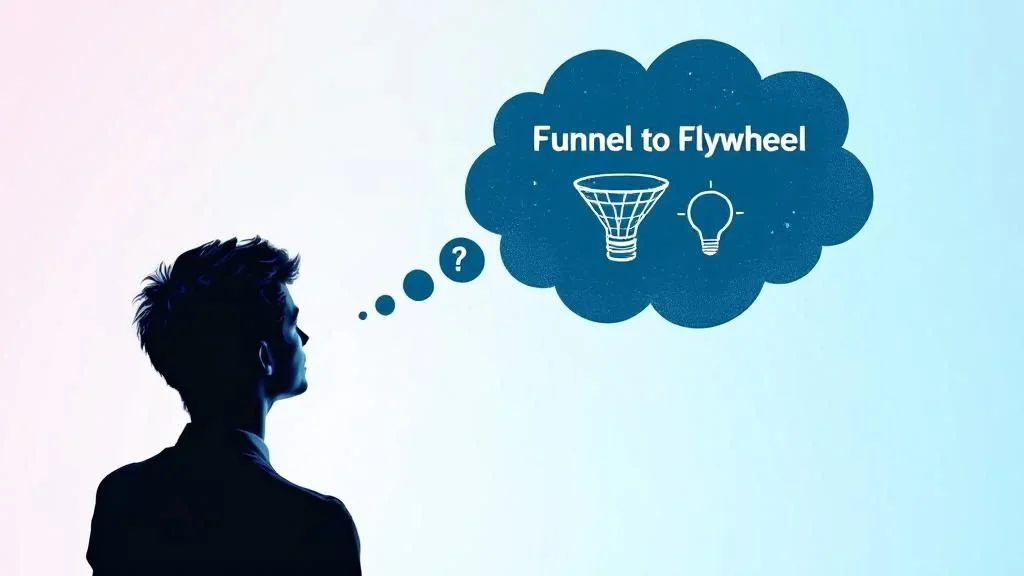From Funnel to Flywheel: Rethinking Your Paid Media Strategy for 2025
Key Takeaways
Transitioning From a Marketing Funnel to a Flywheel Model Enhances Customer Engagement and Retention.
The Flywheel Approach Focuses on Creating a Continuous Cycle of Attracting Customers and Delighting Them.
Paid Media Strategies Should Integrate With Organic Efforts for a Holistic Marketing Approach.
Emphasizing Customer Experience Is Crucial for Driving Sustainable Growth in 2025.
Leveraging Data Analytics Can Optimize the Effectiveness of Your Paid Media Campaigns.
In the rapidly evolving landscape of digital marketing, the traditional marketing funnel is undergoing a significant transformation. As businesses look toward 2025, the shift from funnel to flywheel is becoming increasingly critical. This change emphasizes the advocacy in marketing funnels, which plays a pivotal role in expanding your brand's reach. Advocacy transforms customer retention into broader reach by encouraging customers to publicly support your brand, a vital element often overlooked in traditional marketing funnels. By integrating advocacy into your strategy, you can create a self-sustaining growth model, moving beyond the limitations of relying solely on customer satisfaction.
To thrive in this new paradigm, Operational Agility in Business is essential. Rather than striving for perfection, businesses must focus on agility to navigate the challenges of 2025. This involves embracing diverse suppliers and flexible management practices. As you rethink your paid media strategy, consider how these elements can enhance your approach to attracting customers and optimizing your marketing funnel.
The Science Behind the Flywheel Model
The Marketing Flywheel Concept is revolutionizing how businesses approach their strategies by emphasizing a continuous cycle of improvement. This model is based on the Deming wheel, which involves planning, developing, controlling, and adjusting strategies to maintain momentum. Unlike the traditional marketing funnel, which focuses on attracting customers and guiding them through a linear path, the flywheel model prioritizes ongoing customer satisfaction to sustain growth.
While many believe in the sales funnel vs flywheel debate, there is a strong case for adopting the flywheel model. This approach reflects the evolving nature of customer behaviors, where long-term relationships and positive experiences are crucial for sustained success. By focusing on customer satisfaction, the flywheel creates a self-sustaining cycle that keeps customers engaged and loyal.
The flywheel model explained through its emphasis on continuous momentum. It contrasts sharply with the sales funnel's linear approach by prioritizing customer satisfaction. This shift ensures that businesses can adapt to changing customer needs and maintain a competitive edge. The model's focus on customer engagement stages enhances involvement and loyalty, ensuring that customers remain a central part of the business strategy.
Emerging Trends in Paid Media for 2025
Looking ahead, the landscape of paid media is expected to evolve significantly by 2025. The U.S. digital ad spend is projected to reach an impressive $298 billion, highlighting the growing importance of digital advertising, aligning with the U.S. digital ad spend projection. This surge underscores the need for businesses to adapt their strategies to remain competitive in attracting customers.
AI in PPC strategies is set to revolutionize the field, enhancing both efficiency and effectiveness. By leveraging AI in public relations, marketers can optimize their campaigns, ensuring that ads reach the right audience at the right time. This technological advancement is crucial for businesses aiming to stay ahead in the competitive digital space.
Voice search advertising trends are also gaining traction, with PPC strategies increasingly accommodating this trend. As voice search becomes more prevalent, brands must adjust their advertising approaches to ensure they are capturing this segment of the market. This shift is essential for maintaining relevance and engaging with a broader audience.
Augmented reality in advertising is emerging as a vital tool, offering immersive experiences that bridge digital and physical interactions. By integrating AR, brands can create engaging and memorable campaigns that resonate with consumers, further enhancing their marketing efforts.
Key Statistics in Evolving Media Strategies
The landscape of Media Strategies is undergoing a significant transformation as brands adapt to new challenges and opportunities. According to Nielsen, 54% of marketers plan to reduce total ad spend in 2025, a clear indication of marketers reducing ad spend as companies prepare for a leaner budget year. This shift suggests a strategic reevaluation of how resources are allocated within the marketing funnel, with a focus on more efficient methods of attracting customers.
An intriguing trend is the growing importance of retail media networks. A substantial 74% of marketers express a desire for retail media networks importance to play a larger role in their overall Media Strategies. This shift underscores the increasing significance of commerce media in advertising, as brands seek innovative ways to connect with their audience. Retail media networks offer a unique platform for engaging consumers, providing a direct link between advertising efforts and purchasing behavior.
The growth of global ad spend is evident as it has increased dramatically from $19.8 billion in 2015 to over $270 billion in 2025. This growth reflects the rising confidence marketers have in social advertising, particularly as they navigate the transition from traditional marketing funnels to more dynamic strategies like the flywheel model. Social platforms have become vital in attracting customers, offering expansive reach and targeted engagement opportunities.
Mobile ad revenue dominance is clear, with over 80% of social ad revenue generated from mobile campaigns. This dominance highlights the critical role mobile platforms play in modern Media Strategies, as consumers increasingly rely on their devices for information and entertainment. Marketers are leveraging this trend to create more personalized and immediate connections with their audience.
One unpopular opinion about evolving Media Strategies is that the focus on mobile and retail media networks may overshadow the potential of traditional media channels. While digital platforms offer unparalleled reach and engagement, some argue that traditional media still holds value in building brand awareness and trust. Balancing these diverse channels will be crucial for marketers aiming to optimize their strategies for 2025 and beyond.
Adopting a New Mindset for Marketing Success
In the evolving landscape of marketing, adopting a new mindset is crucial for achieving success. As we approach 2025, businesses are rethinking their paid media strategies, transitioning from traditional marketing funnels to more dynamic flywheel models. This shift is driven by the need to continuously engage and delight customers, rather than merely attracting them. In the next few years, this approach is likely to redefine how companies perceive customer interactions, emphasizing sustained engagement over one-time conversions.
Artificial intelligence plays a pivotal role in this transformation. A significant 68% of CEOs acknowledge AI's impact on business, prompting them to rethink talent management strategies and technology integration. This strategic shift involves a 'build, buy, bot, borrow' approach, where reskilling existing talent and integrating AI into workflows become priorities. Such strategies not only enhance operational efficiency but also ensure that businesses remain competitive in a rapidly changing environment.
Moreover, automation for skill gaps is set to bridge, with 65% of CEOs planning to leverage technology for workforce enhancement. This move underscores the importance of data-driven leadership and a people-powered approach, ensuring that organizations can adapt to disruptions while delivering business value. By staying attuned to consumer behavior insights, companies can align their marketing initiatives to achieve maximum impact, ultimately fostering a more resilient and innovative business model.
Frequently Asked Questions
What is the Flywheel Model in marketing?
The Flywheel Model focuses on creating a continuous cycle of customer engagement and satisfaction, which in turn drives growth through customer referrals and repeat business.How does the flywheel differ from the traditional Marketing Funnel?
Unlike the linear Marketing Funnel, the flywheel emphasizes ongoing customer relationships and feedback loops, enhancing the process of attracting customers and retaining them.Why is it important to rethink Paid Media Strategies for 2025?
Rethinking Paid Media Strategies is crucial to adapt to evolving consumer behaviors and technological advancements, ensuring effective audience engagement and resource allocation.How can businesses integrate the Flywheel Model into their Paid Media Strategies?
Businesses can integrate the Flywheel Model by focusing on customer experience, leveraging data analytics, and fostering customer advocacy to enhance their Marketing Funnel.




